We’re big fans of LED throwies and derivative projects where you light an LED simply by connecting it across the terminal of a small lithium coin cell.
You’ll find this trick used in a lot of our projects that call for simply lighting up an LED in a tiny space, like the temporary LED lanterns, LED Ghosties, Robogames awards,
LED origami circuitry, light-up Lego minifigures, and edge-lit holiday cards. You’ll also find them in those little keychain flashlights– open one up and there’s just a battery and an LED.
So the throwie (and I use the term loosely, referring to devices with or without magnets) is a darned useful thing. But the first time that I was introduced to the concept, I asked what a lot of other electronics-oriented people do: “where’s the resistor?”
Turns out that it’s a fair question. LEDs aren’t normally driven directly from a battery. And yet (1) people were making throwies with every imaginable color of LED and (2) they apparently weren’t exploding. So what’s the deal?
Turns out that the deal depends on what kind of LED you’ve got, and a few more things after that. The “standard” battery for this sort of thing is a CR2032 3V lithium coin cell. Almost any kind of an LED can be found in one of those little keychain flashlights, but throwies usually are made with 10 mm diffused-lens LEDs in assorted colors. Most garden-variety LEDs are rated to operate safely at 20 mA or perhaps a little bit higher. Blue, white, and most modern green LEDs have a typical forward voltage of about 3.5 V when run at 20 mA, and typical red or yellow LEDs have a forward voltage of about 1.7 V when run at 20 mA.
This is actually straightforward for the 3.5 V LEDs. It means that when you put that 3 V coin cell across a blue or white LED, the current will stay safely below 20 mA, because the coin cell does not provide enough voltage to exceed that.
And while this does provide an upper bound, it doesn’t actually say much about what goes on once you hook up the LED. The current through the LED depends exponentially on the voltage across it, and the voltage across the battery depends on the current due to its internal resistance, and a number of other potential factors come into play. If you actually measure it, you might find that the current across the LED looks like this:
This data was taken by hooking a new CR2032 cell across a white LED and measuring the current with a digital multimeter. The current was as high as 11.1 mA, the moment just after it was hooked up. After one hour the current had fallen to 2.75 mA, and had brightness typical for a throwie. Empirically, the data has roughly the shape of a power-law distribution.
If we remove the first couple minutes of data, the remaining part turns out to have a verygood fit to a power function– that will come in handy later. The neat curve fit after the first couple of minutes suggests that perhaps the variation in the first minutes is due to temperature changes at turn-on. So this all looks reasonably well-behaved– obviously safe without a resistor.
Okay, but what happens when we make a throwie starting with a red LED? For red, yellow, and orange LEDs, the typical forward voltage is well below 3 V, usually about 1.7 V, so we would expect that *more* than 20 mA will be produced, at least for a little while. So, let’s try it out. We hooked up a red LED to a new CR2032, and again measured the current. Here’s what we saw:
Wait– 107 mA?!–?
Yes, this is reproducible. (That is to say, we wastedused up another battery just because we didn’t believe it either.) But holy cow anyway.
“And they said this was safe?” There are a couple of legitimate concerns here. Lithium coin cells aren’t designed to source nearly that much power– and aren’t lithium batteries a fire hazard? And why does my LED– rated for 25 mA continuous current survive this? I’ve certainly seen enough LEDs destroyed by overcurrent, and this one was over 25 mA for ten minutes solid. But, and perhaps against my better judgement,
I do believe that this actually *is* safe in practice. With all of the throwies and similar things out there — don’t forget the keychain flashlights — they just don’t seem to be exploding or catching on fire. (Breaking, falling apart, running out of photons, yes– but those modes of failure are usually not as dangerous.)
So, if we are draining this much current from the battery– up as high as 107 mA– is the battery totally dead after just the first half hour? It turns out that we have a fairly good curve fit to the data there, so we can use *ahem* magicto estimate that about 13 mAh worth of energy are consumed in the first half hour. The nominal capacity of our CR2032 is 225 mA*, so that looks like about 6% of our total capacity.
[*225 mA is the nominal capacity. As we’ll discuss a little later, the actual capacity may be much lower when sourcing that much current.]
To get a better grasp on the current that we’re using, let’s look at this over 24 hours:
This data shows a couple of interesting things. First is that the power-law model seems to hold fairly well. Second, the power function that pops out is not very different from that of the data from only the first half hour– integrating both out to 24 hours gives two answers– 150 mAh and 186 mAh –that differ by only 25%. The estimate based on the long data record (150 mAh) is the more accurate one, but this does suggest that we should be able to use the data from the first half hour alone to get a fairly good “factor of two” estimate of the performance over 24 hours.
Now going back to our white LED and our curve fit from the first half hour, we can estimate that the white LED uses about 33 mAh in the first 24 hours, as compared to about 150 mAh in the red LED. Remembering that the nominal capacity of our CR2032 is 225 mA, this is a really big difference.
It gets worse. If you look at the datasheet for a CR2032, you’ll find that they aren’t actually designed to put out high current. The rated 225 mAh lifetime is what you get when the battery is discharged at its “continuous standard load”: 0.2 mA. At room temperature and 2 mA discharge current, the actual capacity drops to about 175 mAh. Under abusive conditions– like being hooked up to the red LED directly– that’s way outside of the chart on the datasheet, but the capacity may be much lower yet. In practice red, orange, and yellow LED throwies can last as little as a day, and this all makes it pretty clear why.
The official line on throwie lifetime is that throwies last “1-2 weeks” depending on LED color and weather conditions. We’ve already talked about LED color, but the temperature thing comes out in the datasheet too– the voltage developed at the terminals and the total energy capacity of the battery drop significantly when you move from room temperature to freezing weather. Remember that the temporary LED lanterns are for warm summer parties: Throwies are a dish best served hot!”
Now in a situation like this where the LED is drawing too much current from the battery, there is a tried and true solution: resistors.
So…. Do you need a resistor? No, not really. As we said, it seems to be reasonably safe without one. Should you use a resistor? Yeah you should, if you want a red, yellow, or orange LED to last more than a day or so. So you can solder a resistor in place, but that somewhat defeats the purpose of easy to assemble throwies.
So to make it not a total pain-in-the rear to add resistors, here’s a way to do it without soldering: just twist it.
Standard throwie parts (battery and LED) plus a resistor. Pick a few hundred ohms. Spread the leads of the LED apart slightly.
Use a pair of pliers to hold the resistor next to either one of the LED leads as shown. That’s so that you don’t strain the LED or resistor when you twist the leads.
Then, twist the lead of the resistor together with the lead of the LED, hard. Ideally use a second set of pliers to do it, it’s pretty quick. It can make a very solid connection by the same principle as wire wrap— the hard square leads of the LEDs bite into the soft copper of the resistor leads as you twist them.
Bend around like so, and treat like you would with a normal LED for a throwie.
Wrap tape around the two leads that go to the battery like you would normally, and then fold over the extra twisted lead pair and tape it down too.
One of the two red throwies here has the resistor; you wouldn’t notice unless you were looking for it.
For the first test of this we used a 200 ohm resistor with a red LED:
The current never exceeded 6.5 mA, producing much less stress on the battery, and the estimated 24 hour power usage is 81 mAh. A significant savings– it may last more than twice as long as a regular red throwie. None the less, from here it would be better to try a larger resistor to see if we can bring the current a bit lower yet– maybe heading towards that 3 mA value that seems to work so well for white LEDs.
Anyway, these are just some of our thoughts on throwies and things. We’d love to hear about your experiences and comments on these issus.




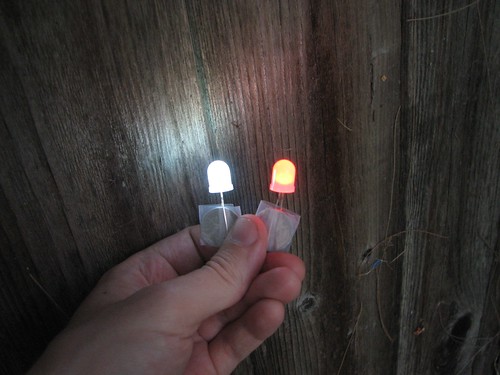
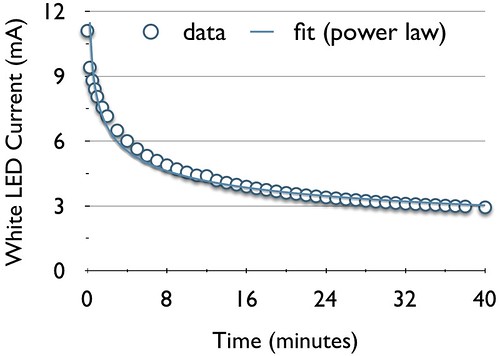
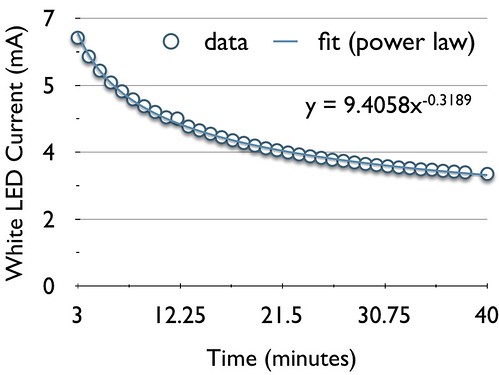
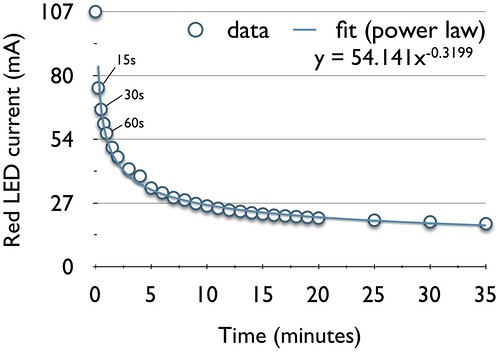

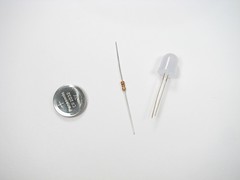
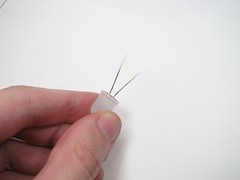

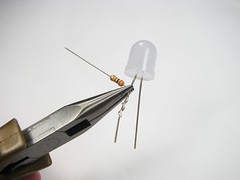


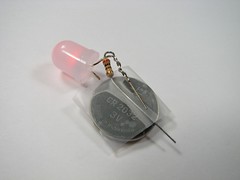
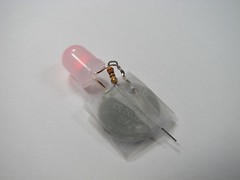
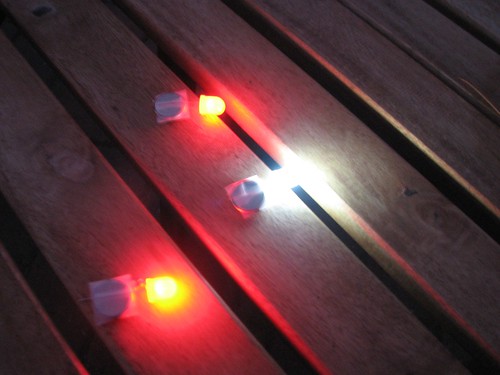
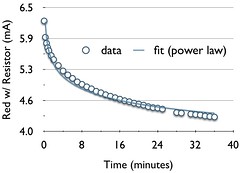
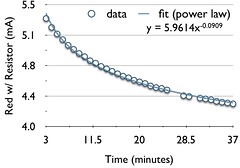
Did you try hooking up two yellow or red LEDs in series to run from a single battery? Their total voltage drop would then be roughly equal to that of a white LED (1.7×2 = 3.4V).
Yes, that was the first thing that I thought of as well. But it did not produce nearly enough brightness. I didn’t dig much deeper into this because it’s already a nonstandard configuration.
The problem is that when sourcing source 2 mA– the very limit of its usual ability– the battery voltage falls to about 2.8 V, due to its effective internal resistance. (Or a lower voltage, if its capacity is diminished– think about how far it has to go down to match the red LED.)
2.8 V turns out to be reasonably bright for a 3.3 V white LED. But it seems like 1.4 V is not enough to run a red LED at reasonable brightness.
—
Windell H. Oskay
drwho(at)evilmadscientist.com
http://www.evilmadscientist.com/
Good to know. How about a plain old diode? That would add (or subtract?) a more reasonable 0.7V (ish ) drop to the circuit.
Yes, that’s an excellent idea; better in many ways than a resistor.
—
Windell H. Oskay
drwho(at)evilmadscientist.com
http://www.evilmadscientist.com/
What advantage is there to using a diode? They are more expensive and less available, they have a fixed voltage, and they are only available in a few voltages. Resistors of nearly any value can be found for pennies, and they will give you exactly the current you want. They also have a variable voltage depending on the current, making a nice little automatic feedback system. If the battery is fresh, it will have more voltage, in which case the resistor will drop more of the voltage. When the battery loses some power, its voltage will drop, in which case the resistor won’t drop as much voltage. Short of building a current source (how LEDs really should be driven if you care about efficiency and/or accurate control), there’s no better way than throwing a resistor in series with it to act as a simple ballast.
That "fixed" voltage can be construed as an advantage.
—
Windell H. Oskay
drwho(at)evilmadscientist.com
http://www.evilmadscientist.com/
I’m maybe just a little worried about the claim about safety without a resistor.
I can toss lit matches into my living room, and most of the time they won’t ignite anything. But the fact that I can get away with it a significant proportion of the time doesn’t necessarily mean it’s a safe thing to do.
I’m curious if there’s any real data on the safety of lithium batteries, as opposed to simply observing that having run one or a few at excessively high current didn’t cause any deleterious effect. I’m far from an expert, so I wouldn’t comment myself on whether it’s safe or not. But it seems like the official warnings might have some basis in reality, right?
I think that you misunderstand what I’m saying.
I do not remotely claim that my observations here mean that red throwies are safe– in fact, if I were to go solely on what I have measured here, I would have said that the first ten minutes that they are on are potentially dangerous– at least to the LED.
So quite the contrary. I base my observation that these are considered safe on the fact that keychain flashlights (and many other devices) that are built *exactly this way* — with a red LED connected to a CR2032 battery– are widely accepted as safe, and seem to be so. Despite there being millions of these in households, we aren’t hearing about them on the news.
—
Windell H. Oskay
drwho(at)evilmadscientist.com
http://www.evilmadscientist.com/
As for actual "will this catch fire" safety, it might be worth doing a little experiment to see how dangerous these button cells really are. Sure Lithium cells have a bad name, but I would be surprised if something as small as a CR2032 actually posed any danger at all.
So… buy a couple of packs of CR2032 from different vendors, lay them all out next to each other, and clamp some wires across them to short circuit the whole lot. Use a probe thermometer (or better – an IR camera) to check the temperature of each of them over the first 10-15 minutes or so. Unless you insulate them or start stacking them (which would also be interesting, in a "will it explode?" kinda way), I doubt they would get up into fire hazard temperature range. Probably not much higher than the bottom of my laptop…
This sounds like a good mythbusters segment…
My take on it is that it’s OK. Worst case you’re sourcing about 200mA at 3V. That’s a whopping 0.5 watts! Not a whole heckuva lot especially when considered over the area of a lithium cell: the surface area should easily dissipate such a small amount of heat.
-lyndon
0.5 W is certainly enough to destroy an LED, and they can sometimes die violent deaths.
—
Windell H. Oskay
drwho(at)evilmadscientist.com
http://www.evilmadscientist.com/
Oh, I didn’t think you were concerned about the LED. I was referring to the fire hazard comment.
Here’s a "dumb moment" from my past: in my first job after college I was stripping 3V lithium cells from boards that failed production test. I put them all in a Ziploc bag without giving it a second thought until someone picked up the bag and said "Oh, these are nice and warm!" Yikes!!! I just shorted together a few dozen batteries. No harm though. The bag was warm, not hot and the plastic wasn’t anywhere close to melting.
I really don’t think there’s enough energy there to start a fire unless the environment is a gas/air mixture at just the right ratio :-)
Exploding lithium hurts. Just be very careful shorting out lithium batteries. Even capacitive discharge spot welding (the norm in the battery industry) can explode a lithium coin cell (I know from experience). Have fun and play safe! ;)
Thanks for this brilliant post. I had wondered about resistors and throwies. Lots of this went above my head, but I get the idea — some colours need ’em, some don’t. Brilliant.
I’ve never done it with throwies, but I’ve needed to package up an LED and a resistor together before and I just cut the one leg of the LED off pretty short, wound the resistor lead around the leg, and applied and tiny bit of solder. If you grab the short lead of the LED and the lead of the resistor together with pliers, you can sort of curl the resistor around it in a quick motion. Once you do it a few times, it becomes quite quick (as, for example, in the case of making a whole batch of throwies).
seen this?
http://www.emanator.demon.co.uk/bigclive/joule.htm
;)
This is somewhat off topic, since the Joule Thief circuit doesn’t address any of the issues that we’re addressing here, but yes we’ve seen it– we linked to it quite prominently in our project:
http://www.evilmadscientist.com/go/joulethief
—
Windell H. Oskay
drwho(at)evilmadscientist.com
http://www.evilmadscientist.com/
You’re a little late the party, Anonymous 5385.
LED’s come in many different forms. The most common and cheapest ones only have a LED. More expensive ones can have circuits inside them or resistors to limit current. Isn’t it possible that the LED’s inside keychain flashlights have a built-in resistor instead of an external resistor?
Yes, there are a zillion LED flashlights out there. I’ve been referring to a specific (and very popular) class of them, that really is built the way that I’ve described it.
—
Windell H. Oskay
drwho(at)evilmadscientist.com
http://www.evilmadscientist.com/
I have done some complimentary analysis on the CR2032 batteries:
http://interactive-matter.org/2009/08/driving-circuits-from-a-cr2032-lithium-coin-cell/
You should positively take into account that the CR2032 are claimed to have an internal resistance of 20 Ohms. They are very far from beeing an ideal voltage source. Perhaps you should redo your tests and watch the voltage across the LEDs.
I think it would be a very interesting thing to throw those two together – I am working on it.
But your post gives me some very interesting insights. since I wanted to force the CR2032 to output more power using an boost converter.
CR2032 seem to be quite fashionable recently ;)
Trying to get the link right:
http://interactive-matter.org/2009/08/driving-circuits-from-a-cr2032-lithium-coin-cell/
Yes, we’ve looked at the voltage, but it seemed a little less useful for the discussion at hand.
In a sense, when we did these curves we *were* also doing detailed measurements the voltage across the LEDs– the current through the LED is not ohmic, but does follow a known exponential curve that depends on the voltage applied across it. If we made a few measurements of the specific I-V curves for the two LEDs we could use them, along with the curve fits to the current versus time, to get a better model of the power output of the battery as a function of time. You could also use this to measure the effective internal resistance as a function of current, power, and remaining energy content of the battery. But I’m not sure how useful it is since it’s not a true (constant) resistance.
—
Windell H. Oskay
drwho(at)evilmadscientist.com
http://www.evilmadscientist.com/
Yes, currently I am thinking about drawing some constant current from the cells and see how it behaves at some (all beyond spec) current levels.
Perhaps even as a function over time.
But perhaps we should not waste lithium batteries, since lithium is getting rare. ;)
When I was in college we used a red flashing LED fixed into a plastic eye covering to give a Terminator like effect, that used one of these lithium cells but I don’t remember if we needed a resistor, perhaps the inbuild flashing circuit brought the current down?
No… little blinking circuits like those don’t actually contain a resistor– they require that the appropriate resistor already be in place.
—
Windell H. Oskay
drwho(at)evilmadscientist.com
http://www.evilmadscientist.com/
I read all of these words, and all I heard in my head was "Bweeeeeeeeeeeeeeeeeeeeeeeee" (I don’t understand!) and all I came away with was that Throwies are pretty :)
Can you share your data, or at least present it on a log-log plot? Power law data should be a straight line on that plot, and non power law points are easier to spot.
I have plotted these log-log, and there aren’t any surprises. But, the program that I used to make these graphs doesn’t have the same level of formatting control for log-log. Maybe I’ll do my best and post the results in the flickr set.
The graphs for which I gave a power-law fit look like clean straight lines, and the ones that aren’t good power law fits have a knee between two different power-law segments. A couple of the points that are outliers on the fits in linear-linear look a little worse on log-log.
—
Windell H. Oskay
drwho(at)evilmadscientist.com
http://www.evilmadscientist.com/
>The graphs for which I gave a power-law fit …
Er, the ones for which I gave a *numerical* power law fit, rather than just showing that a power-law model gives a lousy fit! ;)
—
Windell H. Oskay
drwho(at)evilmadscientist.com
http://www.evilmadscientist.com/
Hi Windell,
Thanks for another great article.
What application are you using to create these graphs?
These were actually done in Keynote– not exactly a high-end plot-making program, but it does make nice-looking output for simple graphs. :)
—
Windell H. Oskay
drwho(at)evilmadscientist.com
http://www.evilmadscientist.com/
Ever drop a Lithium coin cell into a molten solder bath? That could lead to some excitement. ;-)
Dave
So that’s why they always put resistors in those LED circuits. I’ve been building stupid little LED circuits for years, and they always seemed to work fine without resistors. Since they were usually for throwaway projects I never noticed the effects on battery or LED life. None of them ever got real hot, like the way one of those little rectifiers did when I put it in the printed circuit backwards. (It actually melted its own solder. It was burned out, but easy to remove.)
Now I know.
I assume you don’t need resistors for incandescent bulbs, because they already have lots of resistance.
As a followup, you might want to do some current measurements and explanations of microcontroller circuits that seem to safely drive LEDs without current limiting resistors, like your Menorah (http://evilmadscience.com/tinykitlist/44-menorah) or micro-readerboard.
Isn’t this a bit wasteful, throwing all those heavy-metal based batteries around for a temporary light show, then having them end up in the landfill for the next thousand years?
Well, lithium actually is the lightest metal (assuming that hydrogen doesn’t count)– it’s definitely not a heavy metal.
In any case, these batteries *need* to be recycled. As other commenters have pointed out, there is a lithium shortage, and proper disposal of these is essential to their responsible use.
—
Windell H. Oskay
drwho(at)evilmadscientist.com
http://www.evilmadscientist.com/
Lithium is not a "heavy metal."
The easiest way to build long living throwies is using blinking LEDs.
I bought the blinking led throwie packuage S here: blinking throwies
This throwies blinked very bright for around two weeks, the third week still good. And after five weeks now i can see it still blinking a bit when its really dark.
kindly regards
Gerd S.
Throwies are great. We made 40 of them for a party, put them in wine glasses with tracing paper around the glasses (looked like lamps). N.B. no wine at the same time.
When dancing started, everybody took them, put them on their clothes, even in their mouth (not smart though). It was great.
We did not plan the dancing use and that’s what is great with these, everybody gets creative and finds new uses.
This post made me very happy. Glad to see I am not the only one who would wonder about something like this and have it lead to multi-meters and plotting. Nicely done.
I have some keychain torches with a white led in them and they have 2 lithium batteries in series so they run off 6 volts total. They seem to work fine.
Thanks for the idea. I am going to use one instead of a real match in our theater. I can’t decide if I will use a colored or a white with color added (yellow near the tip). I built a lighter (zippo -type) the same way.
Well, I just discovered your article and found it really great !
I was wondering lot of things about throwies like will it work under 3V with a White LED and about lifetime….everything came clear after reading it !
Thank you to share this with the world : )
Can conductive expoxy be used to connect these things? I am making the led ghosties and using the leds in pumpkins and I can never get tape to hold the leads securely. They are always blinking or turning off.
No, conductive epoxy doesn’t generally work well for *anything* and may make recycling your batteries more difficult. You may need to carefully pre-bend your LED leads, so that they act like a spring clamp to make good contact with your battery.
Windell H. Oskay
drwho(at)evilmadscientist.com
http://www.evilmadscientist.com/
So…would a resistor extend the life of a white/blue/green LED? I’ve thought of a little home decorating project after my first throwie binge, but changing the batteries every week or so does not look like success to me. Are resistors the answer, or do I need to rig something up with switches, or maybe a light sensor…?
If you are doing something that needs to last more than a few weeks, I’d suggest using rechargeable batteries or a plug-in power supply. Using low-capacity disposable batteries on a regular basis is wasteful in comparison to other means of powering your LED.
Windell H. Oskay
drwho(at)evilmadscientist.com
http://www.evilmadscientist.com/
Thanks!
Anybody able to point me towards some LED/AA/AAA mods?
Hey there, sorry if you’ve covered this, there are so many comments for many different pages:
I have a gazebo in my back yard and I’ve used the paper latern throwies scenario a few times, which I like.
However, I want to be able to hang LED’s in a line on the rafter(s) and daisy chain them with wire to run off of one battery. Is this possible?
Thanks,
K2
What you want is a string of LED Christmas lights.
how do you hook up the xmas lights to a battery?
You buy a set that’s already pre-wired with a battery box. An internet search on "battery powered LED christmas lights" returns many, many, many results.
WORD! Thanks.